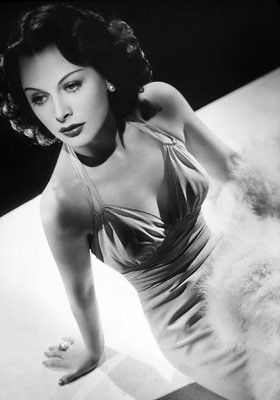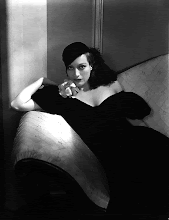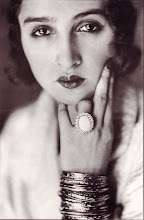
Born in 1909 in Budapest, Hungary Laszlo Willinger was a photographer most noted for his portrait photography of movie stars and celebrities during the 1930s and 1940s.
Willinger's father owned a news agency, his mother was a photographer. He learned photography from them.
After studying in Berlin, Willinger established his first photographic studio in Paris in 1929. In 1931, he established a second one in Berlin. At the same time, he worked as a freelance photojournalist for Berliner Illustrierte, Hamburger Illustrierte, and Munchener Illustrierte, stringer for London Daily Express and Keystone View, and at Talbot Studio, Paris, as advertising and portrait photographer. Subjects include Josephine Baker, President Paul Doumer, Sacha Guitry, and Yvonne Printemps. (What a busy little bee.)
In 1932 he made his first visit to America on an assignment for Mercedes-Benz. Wouldn't you love to see some of those car pictures? Sadly, I can't find any.
He left Berlin in 1933 when Adolf Hitler became Chancellor, (who wouldn't?) and settled in Vienna, where he quickly established another studio. Between 1933 and 1937 he was unable to obtain the necessary permits, (because Adolf was in charge? not sure) so any photographs reproduced in German photo annuals during this period were credited to his mother, Margaret Willinger. (Again, I would love to see some of these pictures.) Despite this, he began to photograph such celebrities as Marlene Dietrich, Hedy Lamarr, Sigmund Freud, Carl Jung and documented the stage productions of Max Reinhardt.
This signed Willinger portrait of Frued was sold in auction by Bonhams in 2006
In the mid 1930s he travelled through Africa and Asia before being invited in 1937 by photographer Eugene Robert Richee to move to the United States. There he replaced Ted Allan at MGM. (This is a major life change to sum up in a couple of lines - How did he meet Richee? Was Ted annoyed at being replaced or had he moved on to bigger, better things? I will answer these questions if I ever find out. NEWSFLASH: just read this: In Vienna "[he met] with Louis B. Mayer, who was looking for talent for MGM Studios. Willinger was hired by Mayer along with Hedy Lamarr – the two came to Hollywood together, hence the many pictures of Ms. Lamarr." )
He established a studio in Hollywood, California specializing in color work for studios (strangely, most of the Hollywood portraits I've found so far have been black and white) and advertising agencies and editorial photography for magazines. Willinger became a frequent contributor to magazines and periodicals, providing magazine cover portraits of some of the most popular stars. Willinger was one of the first Hollywood photographers to experiment in the use of color.
Recalling the 30’s and 40’s, Willinger said he didn’t think there was any time in history when more people so talented on every level had ever been together as in the Hollywood of those decades. For those of us who didn’t live them, those years seem so glamorous and exciting, especially when reflected through the brilliance of this legendary Hollywood photographer.
In those days, publicity went on all year long. In terms of the actors, it didn’t matter whether they were in a movie or not. Everyone was under contract - not for a picture, but for a specified period of time, generally seven years. People were groomed and brought up slowly. Judy Garland, for example, was under contract for two years before she played her first bit part. Actors took lessons eight hours a day, every day; dancing, singing, talking, moving, before any of them ever saw a camera. The men had to learn fencing and horseback riding, swimming and all those things.
Most actors came out of nowhere. They were chosen simply because they were good looking. Some of today’s actors would never have had a chance! They wouldn’t have been pretty enough. Acting was secondary. That, it was figured, could be taught.
Among the stars Willinger most enjoyed photographing were said to have been Joan Crawford, Vivian Leigh, and Clark Gable. What characterized these three stars was their professionalism. They knew what was expected of them. As an actor you were there to be looked at and understood better. These stars not only cooperated, they were eager. Some actors didn’t understand this, and you never heard from them again.

Willinger acted as the art director when photographing the stars. The only thing expected of him was to make images that the press would choose to print over everyone else’s. There could be up to 5000 pictures available on any major star. To get printed, your photograph had to be the best. One thing he always kept in mind, regardless of the subject, is that the photograph has a purpose – and that’s to sell. Consider when someone thumbs through a magazine; he spends about 1/3 second on each page. If your photograph can make him look for three seconds – that’s one good shot! He felt that photographs had to stand on their own – without caption. If you had to explain it, it wasn’t good.
One known fact about photographs from Willinger’s time was that all photos of stars were heavily retouched. In its prime, MGM alone employed around 20 retouchers! Amazing if these actors were so good looking, why all the retouching? Willinger’s reply: “There’s always room for improvement. Also, don’t forget that in those days they used a water-based Max Factor make-up, which had to be applied thickly in order to be smoothed out properly. Unfortunately, it wasn’t good for the skin, and often created pockmarks. When you photographed actors who had been using it for 20 – 30 years, you were dealing with some terrible, ruined complexions.”
Laszlo Willinger left MGM in 1944. After that he shot exclusively for advertising and stock photography. For 40 years he was at FPG, an agency in New York where he had something in the range of 50,000 transparencies on file.
Edward Weston met Laszlo Willinger in the 1970’s through and with John Kobal. Willinger had long since been a Hollywood glamour photographer in Europe in the 1930’s shooting personalities for Louis B. Mayer who hired him in 1937 to shoot Hedy Lamarr in Vienna. After many years of rivaling Hurrell and Bull, he turned his talents towards shooting animals, children, scenes, flowers, people, etc.,etc. and built a library of stock photography and had representatives in Europe, the United States and Asia – in addition to working with Kobal and Weston.
Ed Weston lived in Los Angeles and New York and Willinger in the San Fernando Valley so they were geographically close which enabled them to become well acquainted. Weston purchased many original vintage, period and signed Hollywood Glamour photographs, negatives and rights doing glamour posters and prints which Willinger signed in limited edition.
Upon Laszlo Willinger’s death, 8 August 1989, Ann and Edward Weston continued their relationship with Yvonne Willinger; help sell the Willinger home, advise her about legal documents and paperwork and aided her in moving back to England. Weston would meet with Mrs. Willinger in London over the years and her trips to Los Angeles - staying with both her own family and at the Weston’s house as well.
Mrs. Willinger was working on a book on Willinger’s career, which, unfortunately was never completed. It was to cover their love affair over 50 years, life in Germany during the Nazi period, Laszlo’s move to Vienna in the 1930’s, his famous photograph of Sigmond Freud and his meeting with Louis B. Mayer. The rest is history! Filling George Hurrell’s shoes wasn’t easy but talent will win out. Willinger was one of the top three Hollywood Glamour photographers – Hurrell, Willinger and Bull.
He died 8 August 1989, and was survived by his wife Yvonne Willinger.
Willinger's portraits have become collectible and are appreciated as fine art. His 1940 series of portraits of actors Laurence Olivier and Vivien Leigh are housed in London's National Portrait Gallery.
Here is my Laszlo Willinger Flickr set and here is a whole gallery of photos he took of Norma Shearer



















2 comments:
Great post and beautiful photos. I thought you might be interested to see some of Willinger's "racier" photos here: http://carinemily.com/galleries/. If you search for his name you'll find about 6 semi-nudes he shot.
I found these in some old girlie magazines and found your post while trying to identify the signatures. So, thanks for your help!
Thanks you for the link, darling. Absolutely fabulous.
Post a Comment